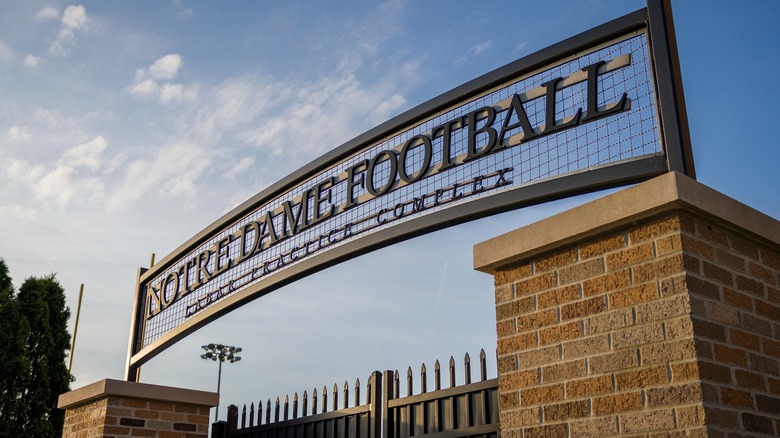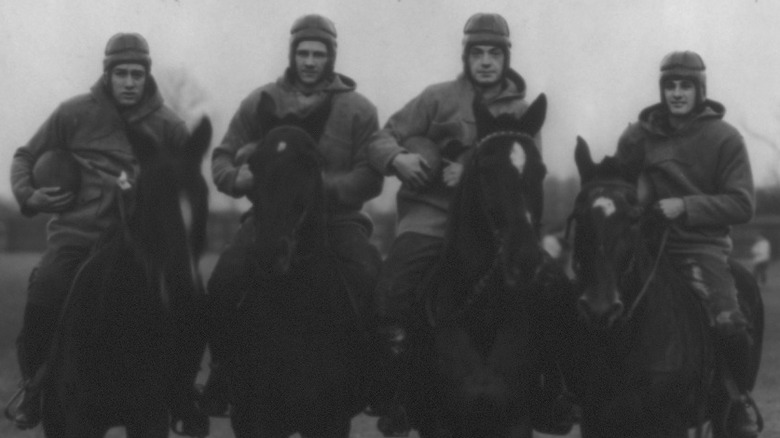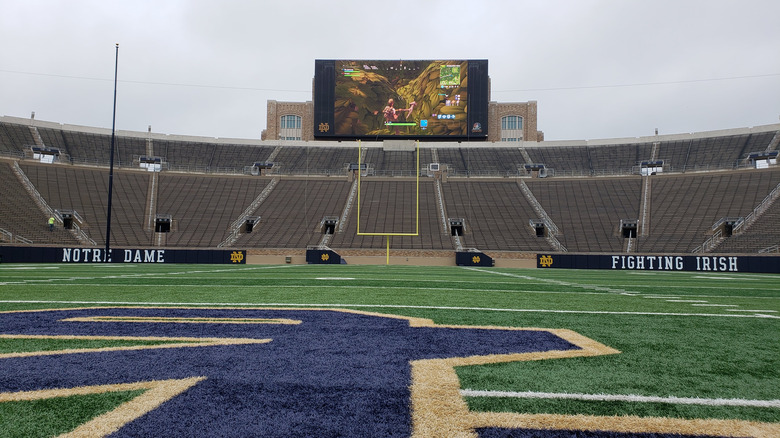The Meaning Behind The Famous Four Horsemen Backfield Of Notre Dame Football
Though it's been a top-tier sport in the U.S. for generations now, there was a time when professional football, which would later coalesce under the auspices of the National Football League (NFL), failed to get much interest, according to ESPN. Whatever professional football existed in those days (the 1920s-1930s) was mostly just clubs for men who had played in college to have an outlet for their athletic endeavors.
That's not to say that football wasn't popular in those days — it certainly was, and in fact, it was huge. It's just that Americans didn't pack into the stands of professional teams; they went to college games. And in those heady, early days of the American college football landscape, there was no bigger team than that of Notre Dame. For a few years in the 1920s, they were essentially unbeatable, thanks in large part to its coach, the legendary Knute Rockne, and a backfield consisting of four men who so thoroughly dominated their sport that they were given the nickname "The Four Horsemen."
The Four Horsemen of the Bible vs. the Four Horsemen of Notre Dame
The concept of four men on horses representing something significant comes from Chapter 6 of the New Testament's Book of Revelation (per Bible Gateway). In the prophetic passage, the writer refers to seeing four riders atop four horses, one each representing death, war, famine, and pestilence. Christendom has since collectively referred to these figures as the "Four Horsemen of the Apocalypse."
In the early 1920s, Notre Dame's backfield (pictured above, actually on horseback) — its quarterback, left and right halfback, and fullback — were so dominant that in 1924 the four men who played those positions were given the title "the Four Horsemen" by a New York sportswriter, Grantland Rice of the New York Herald-Tribune, according to Notre Dame University's website. When they ran down the field in concert with one another, woe betide anyone who got in their way.
Notre Dame's Dominance With The Four Horsemen
To understand why Notre Dame was so dominant during the era of the Four Horsemen, it helps to understand how football was played in those days. The modern game, as History notes, relies largely on the forward pass. Nothing energizes the crowd like the quarterback connecting with a wide receiver with a 40-yard bomb that scores a touchdown. In the 1920s, however, football was almost exclusively played on the ground. In fact, Notre Dame's coach at the time, Knute Rockne, practically invented the forward pass when he was a player, and though it was a thing by the Four Horsemen era, the game was still largely based on running, not passing.
When quarterback Harry Stuhldreher, left halfback Jim Crowley, right halfback Don Miller and fullback Elmer Layden had the ball, there was no stopping them, according to the University of Notre Dame website. That led sportswriter Grantland Rice to report, "Outlined against a blue, gray October sky the Four Horsemen rode again. In dramatic lore they are known as famine, pestilence, destruction and death. These are only aliases. Their real names are: Stuhldreher, Miller, Crowley and Layden."
During the three seasons in which the Four Horsemen played together, Notre Dame went 30-2. They lost just twice, both of them away games at Nebraska.


